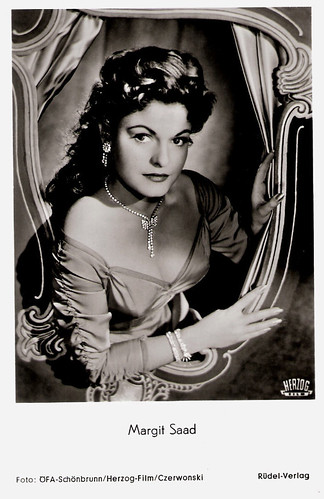
German postcard by Rüdel-Verlag, Hamburg-Bergedorf, no. 844. Photo: ÖFA-Schönbrun / Herzog-Film / Czerwonski. Publicity still for Hab ich nur deine Diebe/I only have your love (Eduard von Borsody, 1953).
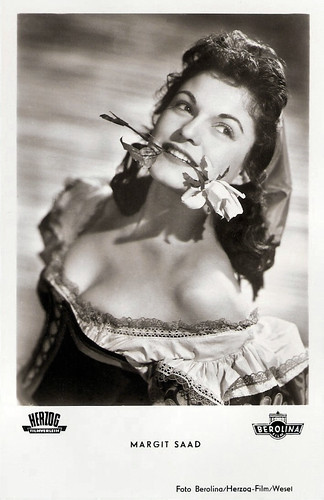
German postcard by Kunst und Bild, Berlin, no. A 1128. Photo: Herzog / Berolina. Publicity still for Der Zigeunerbaron/Baron Tzigane/Gypsy Baron (Arthur Maria Rabenalt, 1954).
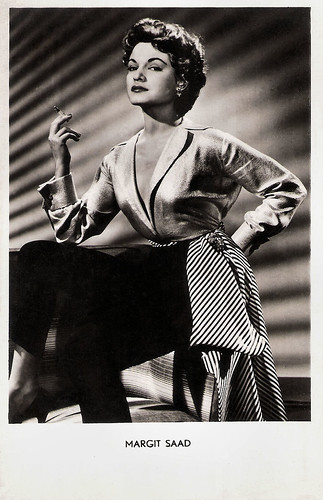
Vintage postcard, no. 103.

Austrian postcard by Kellner-Fotokarten, Wien, no. 987. Photo: Constantin-Film / Berolina / Wesel. Margit Saad in Was die Schwalbe sang/What the swallow sang (Géza von Bolváry, 1956).
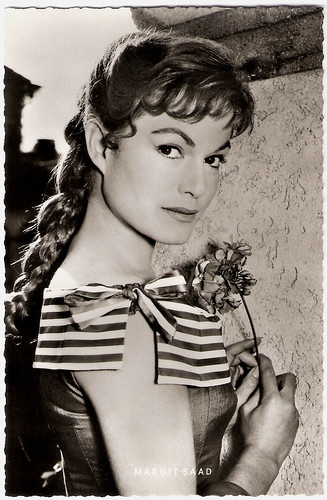
German postcard by Kunst und Bild, Berlin-Charlottenburg, no. T 864. Photo: Bavaria / Schorcht / Vogelmann. Publicity still for Ein Stück vom Himmel/A Piece of Heaven (Rudolf Jugert, 1958).
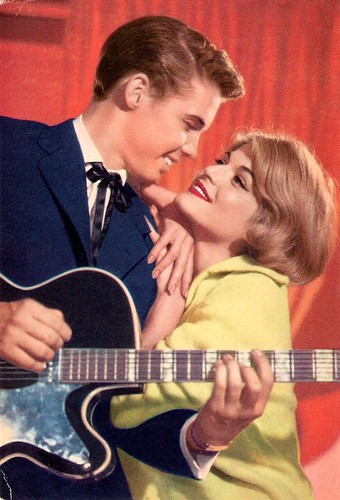
German postcard by ISV, no. H 43. Peter Kraus and Margit Saad in Melodie und Rhythmus/Melody and Rhythms (John Olden, 1959).
Daughter of a Lebanese language professor
Margit Daisy Saad was born in Munich, Bavaria in 1929. She is the daughter of the Lebanese language professor Fuad Jabbour Saad and German language teacher Agnes Saad, born Diepgen. Margit studied acting at the Otto-Falckenberg-Schule in Munich. To finance her studies, she worked as a model. She had her first stage engagement in Düsseldorf.
Saad made her screen debut in the Austrian comedy Eva erbt das Paradies... ein Abenteuer im Salzkammergut/Eva Inherits Paradise (Franz Antel, 1951), starring Maria Andergast. She also appeared as a nun in the West German drama Hinter Klostermauern/The Unholy Intruders (Harald Reinl, 1952) starring Olga Tschechowa, Frits van Dongen (a.k.a. Philip Dorn) and Katharina Mayberg.
She played leading roles in the romantic musical Südliche Nächte/Southern Nights (Robert A. Stemmle, 1953), the operetta Baron Tzigane/Gypsy Baron (Arthur Maria Rabenalt, 1954) with Georges Guétary, and the romantic comedy Drei Mädels vom Rhein/Three girls from the Rhine (Ernst Jacoby, 1955).
In the Swedish-German coproduction Sommarflickan/Swedish Girl (Håkan Bergström, Thomas Engel, 1955), she had a part opposite Maj-Britt Nilsson and Karlheinz Böhm. A popular success was the West German crime-comedy Peter Voss, der Millionendieb/Peter Voss, Thief of Millions (Wolfgang Becker, 1958) featuring O.W. Fischer. It was based on the 1913 novel Peter Voss, Thief of Millions by Ewald Gerhard Seeliger, which had been previously adapted into three films.
In France, she appeared in Les dragueurs/The Dredgers (Jean-Pierre Mocky, 1959). Other films that year were Heiße Ware/Hot Goods (Paul May, 1959) with Ivan Desny, and the teen musical Melodie und Rhythmus/Melody and Rhythms (John Olden, 1959) with teen idol Peter Kraus.
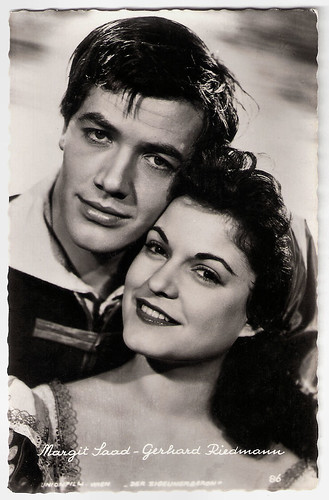
Austrian postcard by Verlag Hubmann, Wien, no.3837. Photo: Unionfilm, Wien. Publicity still for Der Zigeunerbaron/The Gypsy Baron (Arthur Maria Rabenalt, 1954) with Gerhard Riedmann.
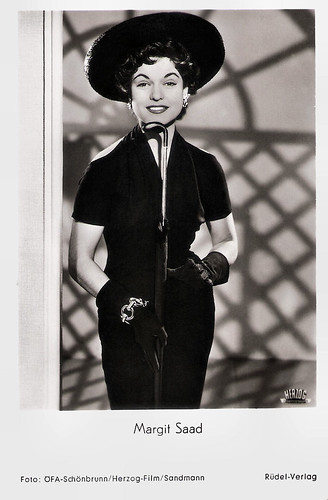
German postcard by Rüdel-Verlag, Hamburg-Bergedorfno. 1265. Photo: ÖFA / Schönbrunn / Herzog-Film / Sandmann. Publicity still for Ehesanatorium/That's Love (Franz Antel, 1955).
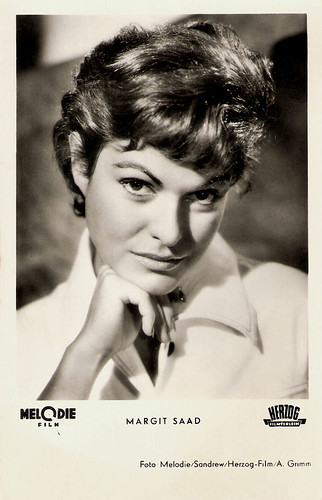
German postcard by Kunst und Bild, Berlin-Charlottenburg, no. I 436. Photo: Melodie / Sandrew / Herzog-Film / Arthur Grimm. Publicity still for Sommarflickan/Swedish Girl (Håkan Bergström, Thomas Engel, 1955).
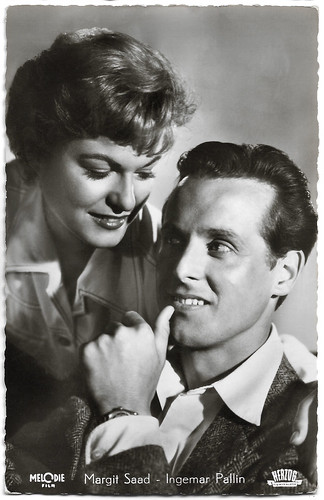
West German postcard by Kolibri-Verlag G.m.b.H., Minden/Westf., no. 1666. Photo: Melodie / Sandrew / Herzog-Film / A. Grimm. Margit Saad and Ingemar Pallin in Sommarflickan/ Schwedenmädel/Swedish Girl (Håkan Bergström, Thomas Engel, 1955).
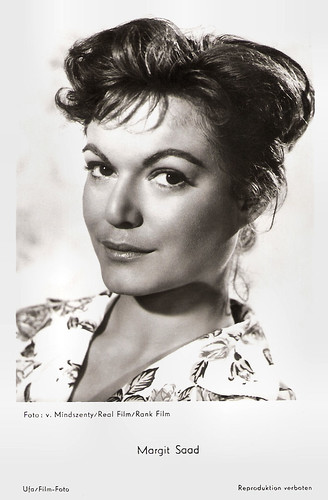
German postcard by Ufa, Berlin-Tempelhof, no. FK 3302. Photo: v. Mindszenty / Real-Film / Rank Film. Publicity still for Drei Birken auf der Heide/Three birches on the heath (Ulrich Erfurth, 1956).

Austrian postcard by Kellner-Fotokarten, Wien, no. 949. Photo: Constantin-Film / Berolina / Wesel. Margit Saad in Was die Schwalbe sang/What the swallow sang (Géza von Bolváry, 1956).
The film's seedy milieu and sadistic streak
In 1960 Margit Saad starred in the British drama The Criminal (Joseph Losey, 1960) with Stanley Baker and Sam Wanamaker. Mario Gauci at IMDb: “While essentially character-driven, the film's seedy milieu and sadistic streak allows for a number of vivid sequences (though the race-track robbery itself is rather thrown away!) including the wild party held at Baker's flat on being released from prison (highlighting sexy Margit Saad who subsequently replaces Jill Bennett as Baker's moll), the equally chaotic prison riot, Baker's escape from the penitentiary (having been betrayed after the robbery and recaptured) and the inevitable showdown with the ruthless Wanamaker.”
She followed it up with appearances in other British films such as The Rebel (Robert Day, 1961) with Tony Hancock and George Sanders, and the low-budget thriller Playback (Quentin Lawrence, 1962). The latter was one of a series of British films based on Edgar Wallace novels, released between 1960 and 1965. On TV she appeared opposite Roger Moore in an episode of The Saint, The Saint Sees It Through (Robert S. Baker, 1964). And in the cinema, she supported TV comedians Eric Morecambe and Ernie Wise in The Magnificent Two (Cliff Owen, 1967).
In Germany, she co-starred with Stewart Granger in the Edgar Wallace crime film Das Geheimnis der drei Dschunken/Code Name Alpha (Ernst Hofbauer, 1965). In 1966, Saad appeared in an episode of the American television espionage series Blue Light, starring Robert Goulet and Christine Carère. It was edited together with three other episodes into the feature film I Deal in Danger (Walter Grauman, 1966), which includes her appearance.
Later she also appeared in Grauman’s war film The Last Escape (Walter Grauman, 1969) starring Stuart Whitman. It was her last film, but she continued to appear incidentally on German TV. Saad also started to direct TV films, including the drama Die Geschichte vom guten alten Herrn und dem schönen Madchen/The Story of the good old gentleman and the beautiful girl (1986) with Peter Pasetti.
From 1957 till his death in 1988, Margit Saad was married to noted French opera director Jean-Pierre Ponnelle. They had one son, conductor Pierre-Dominique Ponnelle.
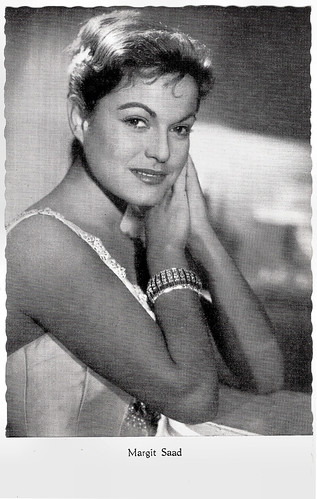
German postcard by Kolibri-Verlag, Minden/Westf., no. D 40. Photo: Berolina / Constantin / Wesel. Publicity still for Was die Schwalbe sang/What the swallow sang (Géza von Bolváry, 1956).
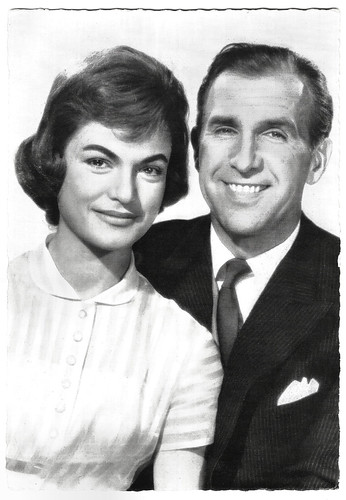
German postcard by WS-Druck, Wanne-Eickel, no. 309. Photo: Unionfilm / Wanka. Publicity still for Ein Amerikaner in Salzburg/An American in Salzburg (Helmut Weiss, 1958) with Bruce Low.
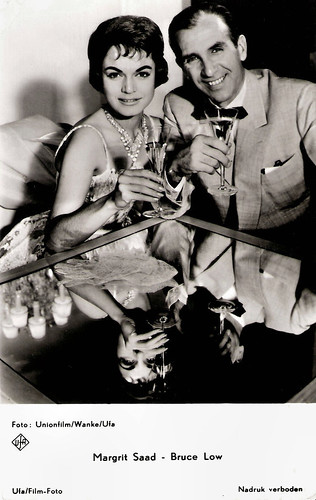
Dutch postcard by Gebr. Spanjersberg N.V., Rotterdam no. 1488. Photo: Unionfilm / Wanke / Ufa. Publicity still for Ein Amerikaner in Salzburg/An American in Salzburg (Helmut Weiss, 1958) with Bruce Low.

West German postcard by Kunst und Bild, Berlin-Charlottenburg. Photo: Gloria-Film / Wesel. Margit Saad and Eddie Constantine in Hoppla, jetzt kommt Eddie/Hoopla, Now Comes Eddie (Werner Klingler, 1958). Sent by mail in 1960.
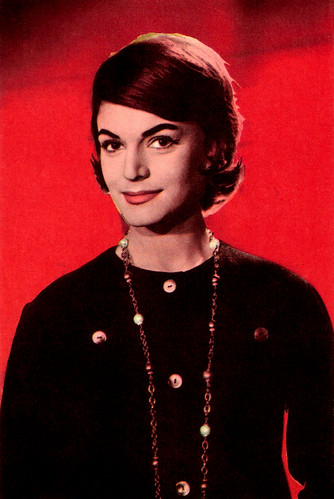
Belgian postcard by Cox, no. 48.
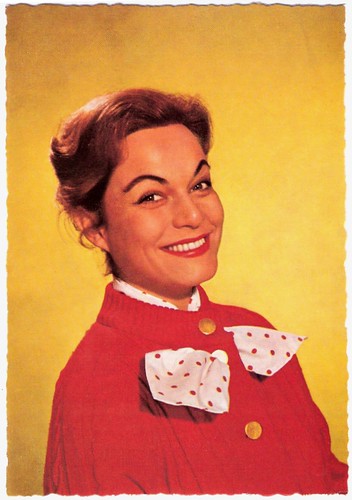
German postcard by WS-Druck, Wanne Eickel, no. F 101. Photo: Klaus Collignon.
Sources: Mario Gauci (IMDb), British Film Institute, Wikipedia (English and German) and IMDb.
No comments:
Post a Comment